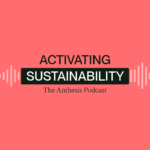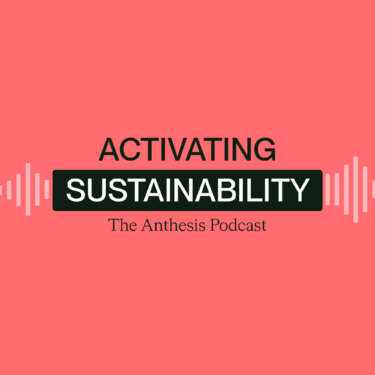
Speakers
Chris Peterson, Director
Gray Maguire, Carbon Project Manager
Bianca Nijhof, Global Lead for Nature Growth
Jos Cozijnsen, Carbon Specialist
Share this episode
In this Activating Sustainability episode, our host Chris Peterson is joined by Gray Maguire, Carbon Project Manager and Jos Cozijnsen, Carbon Specialist, both with Climate Neutral Group, a part of Anthesis, and Bianca Nijhof, Associate Director with Anthesis.

Read the transcript
Chris: Hello and welcome to Activing Sustainability, the Anthesis podcast. I’m your host, Chris Peterson. Today we’re really excited to be joined by a number of colleagues to really dig into the meetings and events happening at Cop 27 and get really quick reactions to what they’re seeing, what they’re hearing, and what myself and all of us as listeners need to kind of know has happened and what are those implications for us going forward?
So please join me in welcoming to the podcast Gray McGuire, carbon project manager with Climate Neutral Group based out of South Africa, Jos Cozijnsen, Carbon Market Specialist with the Climate Neutral Group out of the Netherlands. And Bianca Nijhof, director of Nature and Water with Anthesis Group, uh, currently based in Barcelona, but often based out of the Netherlands as well.
So, thank you all very much for joining. Really appreciate you doing. Thank you. Mm indeed. Yeah. Good to see you. Well, wonderful. Great. I know you are just back from attending COP and some of the early meetings and kind of initial week of it and would love to hear kind of what was that experience like?
What are you seeing? What was kind of the feel of. The event, as I know you’ve been to a number of these.
Gray: Yeah, so, uh, I mean, I, I don’t quite have the same, uh, level of experience as some of my other colleagues in the, in this, uh, department, but, uh, it was my first cop in, uh, I think probably eight years. So yeah, it was definitely a bit of getting used to the, the frenetic nature of the cop.
Again, they, they’re always very fast paced. There’s always so many different things going on at any given moment in time, there’s you. Five, six meetings busy happening that you wanna be able to participate in. And it really is, you know, it’s quite tricky in order to be able to, you know, get to that point of prioritization where you really can just select the key gems that you’re wanting to be able to get to, was definitely made harder by the fact that there were quite a lot of, uh, organizational, logistical challenges.
A lot of the sort of, Guidance, uh, support stuff that was supposed to be in place, like the, you know, the app that, uh, one was supposed to use that was put there by the organizers, didn’t work. Uh, there were obviously quite a lot of, uh, other challenges that some of the listeners on the podcast might have read about in the media around access to food and water, which didn’t help.
Uh, and then, you know, just, uh, also just some audible, uh, challenges as well. But once we started to get past that, uh, yeah, things really started to come together. I think as with many cops, a bit of a bumpy start in the beginning, quite a few blockages around key pieces of texts. I’ve got quite a lot of the, the text was still left being left in in brackets, which means it’s still up for negotiation.
Uh, from our side of things, I mean, I was very focused on article six, which is the carbon markets component of, uh, the Paris Agreement. So I was, I was following that and yes, certainly while there was some progress that was being made, it was so quite a few of the, the key sticking points kind of remained in place right up until when I left.
So I’m keeping my eye on what is happening there during the remainder of this week. Uh, and hopefully we can get some resolution there. But yeah, just in terms of the overall feeling of the cop, I think one of the things that was a bit of a concern was that, you know, with Glasgow there was, uh, even though I wasn’t there, I was obviously following that very closely and there was this very strong sentiment around keep 1.5 alive.
Uh, whereas now all of a sudden there’s new languages, which has started to creep in around every fraction of a degree counts. You know, really what what they’re saying there is, you know, every fraction of a degree below two degrees centigrade counts. And yes, that’s undoubtedly, uh, correct. However, the reality is, is that at 1.5, you know, beyond 1.5 degrees, of warming then what we find is that four or five key global tipping points of climate tipping points move from being possible to to likely, uh, and you know, two of those are essentially the complete disintegration of the Greenland ice sheet is the one.
And then the other one is the West Arctic ice sheet. And if that happens, that that could literally stop the, the thermo heating cycle of the ocean, which is essentially what drives the Atlantic Meridian or overturning circulation system. That’s the weather regulating system that keeps essentially Europe from becoming an ice block and keeps, uh, much of the Latin America and also Central Africa that keeps that moist.
So that could have really, really negative impacts. And then the other thing that could also potentially happen there, the other tipping. Is that the northern permafrost, uh, can start to thaw. And if that were to happen, then, you know, that could end up in a situation. We have uncontrollable greenhouse gas emissions, so we really do need to, uh, keep our eye on that.
Chris: Another rosy picture around it. And I know we’re gonna get into those key themes, right? And what are the things we really need to be focusing in on? I guess maybe just curious to hear, I know Jos, Bianca, you’ve been involved in a number of these cops as well, you know, and Gray, I think your perspective, did this feel different or did this feel similar?
Like, does it feel like people are kind of giving up on 1.5? Does it feel like people are becoming more pragmatic around that? You know, like what is, what is your view of that? Just general experience.
Gray: One of the things that you know is quite alarming for me was that, uh, Washington and the EU issued a joint declaration alongside Japan, Canada, Norway, Singapore, Britain, which is essentially pledging action to build on an international deal that was launched at at Glasgow last year to cut economy-wide emissions by about 30% in a, in about 130 countries around the world.
However, the reality is, is that if we intend to make that 1.5 degrees, Targets, and that’s by 2030 we need to cut emissions by 45%. So we are, you know, 15% short on that. So, you know, what is my feeling around that? My feeling is that we really need to ramp up a lot of the ambition there. And it does definitely feel that there’s a lot of blaming of the, you know, the, the inflation issues and the energy crisis issues that are happening as a result of Ukraine, uh, on the lack of ambition in that regard.
Chris: Yeah. And Jos and Bianca, I know you’ve been watching this from afar, um, but curious to hear kind of what this is feeling like for you.
Jos: Yeah, Chris. Indeed, it is a difficult year this year and it’s also the first cup that I am not visiting cuz I thought, hey, we have not a cover market rules, now we can implement it.
But it’s a very difficult time and everybody is now waiting for how to close that gap. Hour one half degrees. Uh, what we hire targets we will. Because all governments decided in Glasgow, we’ll meet each other every year and we will keep on increasing and increasing our targets. The timing is not there yet, although there are many ambitions, uh, announced again.
Uh, of course our clients will ask for that. What’s happening? Will we meet the overall target or are we just messing up as a, as a company on ourselves? There are many announcements on renewable investments. On helping South Africa, Indonesia, with energy transition, which is very important. There’s some announcement on forestry working together among Grove, and the EU is announcing to increase their target from 55 to 57%.
So, I think that’s good, that at least these small bits of action are there. It’s not enough, and we will talk later about how to close that gap with bridging. Bridging, bridging. We can do. Methane: It’s a very good point you made. I expect there will be an announcement on methane at the end of this. Last year, the government said we will have to reduce 30% of methane in 2030. And for CO2, that means more than 80% at times. The, uh, the value regarded global warming. So that’s good, but I, I’m waiting for a concrete, uh, announcement. Then also a companies also looking for what’s happening with finance. We also see a big, yeah, finance. And it’s difficult at this moment to do this. I guess we will see also companies having a become a role there.
For example, Carrie’s asking the companies in the US to help finance energy transition, for example. So it’s difficult to, to get the finance get closed and the decision today will be made that next year we will have to build this fund. And the third bit is I would like to see what will happen on markets.
And I think what comes out of this COP clearly is there’s an end to greenwashing. If a company seeks to, uh, do work on climate, it should be really absolute emission reduction target in 2050, 2030. If you use compensation to get to zero, use high quality offsets. What we always do as, uh, as Anthesis Group, And then the last one is, don’t invest in new fossil fuels.
If you do those three things, you can have your net zero target and use the carbon market. The carbon market that was decided in Glasgow last year is how countries can use the carbon market at meet global targets. We are not there yet. It’s a lot of, uh, tasks to do. What are the national emissions? How do you report and track emissions?
How do you prove you have reduced your emissions so that you can sell reductions to another country? We’re not there yet to help meet the country’s targeted markets. That’s why we end up with an important role for the voluntary carbon markets, and that’s what we are and our clients are using.
Chris: That’s great. And Bianca, kind of your experience with COP 27 and I think, we’ll, we’ll definitely get into these themes and kind of dig into them a little bit further, but at that high level, Are there some key takeaways for me?
Bianca: Yeah, the high level, and obviously I’m coming at it more from a nature and, and a water angle. Um, and what I’ve seen, uh, well in Paris with the cop, um, nature wasn’t actually at the table and, and what we saw happening last year in Glasgow, you saw nature organizations are the focus on nature becoming a much more, much more apparent actually, And this year, especially nature based solutions or natural climate solutions, there’s different ways of how to, how to frame those.
Um, they’re really very, quite prominent at, at the table. And I think nature provides solutions in two ways. It’s from the climate adaptation perspective, like fighting the, the impacts of climate change, which we already see happening. And also from the climate mitigation, uh, side of things. So nature-based solutions could contribute to around 30% of the global mitigation required by 20 30, 20 50 to achieve the goals as, as we have agreed upon.
So, um, yes, I’m very happy to see that nature as a solution is now really, uh, having a position at the table as well.
Jos: You might even see that nature helps to bridge it. Last gap towards emissions, uh, targets and on top of that, nature-based solutions are also used for adaptation. Uh, they use model biodiversity.
It stores carbon. So yeah, that’s the place to go to, to really meet the targets and to serve all other objectives we have.
Bianca: Well then mitigation is actually from three aspects. It’s about reducing destroying nature, but also implementing and improving our nature and creating, creating more nature. But we can dive into that a bit deeper later.
Chris, there’s multiple examples and numbers actually to staff that.
Chris: No, there, there’s a lot to dig in there. And I’ve been scrambling down notes as we’ve gone through of some of those highlights, and it sounds like maybe what would be helpful is just digging in on what are some of those key themes, right?
For those of us, like myself, are interested but maybe haven’t been as embedded as you all are in COP, what are some of those key things that kind of we need to know coming out of this? Right. And maybe Gray starting with you. One of the things you mentioned is that kind of. You know, “Every fraction of a degree counts” versus the “1.5”.
You were talking about some of those tipping points within that, does it feel like that this will be the COP we look back on as like, oh, that’s when we gave up on 1.5 or so?
Gray: No, I don’t think that it is gonna necessarily be the COP where we give up on 1.5, but I think that the changing in attitude is essentially now that there is a lot more placing our bets on technological solutions that don’t yet exist. The level of focus around carbon capture and storage is definitely increased. So, you know, and as Bianca’s saying, you know, yes, definitely there is a huge amount of focus on h a solutions at COP. I mean, at least 40% of the, the side events that are busy taking place on the official UNF C agenda are, in one way or another, related to adaptation and H based.
So, However, at the same time, carbon capture and storage is also already starting to, to feature prominently there. And I think it probably is, uh, the right time to be doing this. You know, if we look at, uh, essentially what is gonna be the outcome of the inflation reduction act in the us, the level of essentially subsidization that is going towards direct air capture, um, for carbon capture and storage, it is quite tremendous.
I mean, it, it’s more than doubling the. That companies who are engaged in carbon capture and storage will be able to get for a ton of carbon. It’s now in an excess from direct air capture. It’s in excess of $80 a ton. So there’s some really, really good financials and incentives in place that are particularly coming out of the US in order to be able to, to help that to really move forward.
But that’s a hell of a big gamble, future of humanity on technologies that don’t as of yet at this moment in time.
Jos: Yeah, that’s a good point. There will be much more intention. That was also on desktop, on on carbon removals gets CO2 outta the atmosphere cuz we need to improve our efficiency, reduce less energy, but you still need to get the CO2 out of the air or find nature-based solutions.
Removals or DI air capture a lot of attention. Also, some caution. How long can we do it? Is it really permanent? How much does it cost? It has to be one of the options in the future. And we have to start now, but we still need to meet our current targets. So that creates a problem on the one half degrees.
There’s also United Nations overshooting committee working. They say, well, suppose we don’t meet the emission target. We need then to do extra work to yet to cool the earth, to have more ob bedo activity, uh, more nature. Cool down. That’s also part of the extra tension on me thing. We need to do much more now.
You know, we need to Cool now. Therefore also the overshoot committee because of political reasons. We may not bridge all those gaps, but we need to do something because uh, yeah, some nations are suffering. Now special attention also got this cop agriculture and food because that’s our, not only damage to harvest, but we need to get it.
And what you also saw, a lot more information on scope three upstream, downstream, and almost all of our clients have to do with the supply to our you downstream and upstream. It’ll be part slowly becoming of your impact zone. If you can have impact there, please do it. Ask your clients to be more efficient.
Uh, ask your suppliers, uh, and your customers to be more, uh, efficient or more nature based. So yeah, we do our best to, to bridge all those gaps, but they all are more clearer in on a radar that would happen to this cup as.
Gray: Sorry, Jos, Just on that point, I dunno if you saw, but there was a launch of a report from the UN’s high level expert group on net zero emissions commitments of non-state entities.
So that is obviously, it’s very heavily related to scope three emissions because you know, the average level of scope three emissions relative to in company emissions is about 5.5 to one. And it’s also, you know, the only types of offsets that you can use. Under Science Based Targets initiative are removal credits.
So that’s either nature based solutions or Carbon Capture in Storage. And really what they’re trying to do there is, I’m sure that some of the listeners up to this podcast would’ve heard over recent months, there’s been quite a big pushback from the financial sector. Around ESG and, and particularly, you know, companies essentially fudging their ESG reports for, for greenwashing purposes, and this high level expert group is in place in order to be able to provide guidance to ensure credible, accountable net zero pledges going forward.
I think that’s gonna be a really important thing.
Chris: Yeah, and it certainly sounds like there’s this solidification of practices, right? And, and a little bit of this messiness feels like, oh, now that this is real, we need very rigid regulations, et cetera around that. And maybe Bianca, just to kind of reach out to you on this, I know I was speaking beforehand, Biodiversity certainly feels like one of those areas, right?
Where it has been kind of on the agenda like, well, yeah, we need to do something, but don’t know what that looks like. How has that looked like for you at this COP?
Bianca: Well, I think slowly, actually, not necessarily only during the COP, but those in the periods they pass, the year before the COP, with all the wildfires, with all the droughts, with everything happening.
If you see, if you have droughts in peatlands, they release methane. If you have wildfires, you obviously have carbon going into the air, and if you degrade nature, obviously less carbon capture. And even with the ocean heating up a warmer ocean can capture less carbon. So there’s all this, the different sinks which we have are slowly disappearing and climate change sexually negatively impacting that.
So it’s double bad impact, which we are having. So, yeah. Yeah. In that sense, I’m, I’m really, really happy to see nature. There’s a significant solution being at the table, providing that it can, uh, capture one third of the carbon emissions, which, which we have, plus it’s about 10 gigatons a year, which nature can capture if we stop degrading the ecosystems and, and actually restore degraded ecosystems.
So, 10 gigatons of CO2 per year. It’s more than the emissions from the entire global transportation sector. That’s a significant amount. Um, and apart from that, just while also adding on social values, um, like a lot of people with adaptation measures in, in place, that’s like 65 billion US dollars in flood protection benefits.
There’s safeguarding 15 million people against flooding by nature based solutions. And if you then can say that if you have those nature based solutions as adaptation measure, they at the same time also. Capture carbon, so it’s a mitigation measure as well. So for me, it’s like a win win-win situation and I’m very happy that that’s what we, I would call a systems approach.
That we are slowly taking that approach. Um, and that for me is also a sway into another important cup from my perspective, at least coming up. Beginning next month where we will be talking about nature and there’s striving for a similar global goal, which we have on climate for nature, and that will support our climate agenda definitely as well.
Chris: Yeah, perfect. And maybe just pick up on one piece in there, Bianca. You know you mentioned about the adaptation piece, and I know Gray, you were commenting previously about that sense of what does this look like for developing countries, the kind of finance mechanisms around those transfers, et cetera.
That seemed like a big focus in the early days of this COP. I’m curious kind of what your perspective on that.
Gray: Yeah, I mean, so just, you know, just prior to the COP, there was a meeting of the Global Center on Adaptation in, I think it was in, it was either Gand or Ghana. I can’t remember exactly where it was.
So that was about a month ago. And the co-chair of the event, uh, made an announcement during, I mean, this was just one of the outcomes of the research that they’ve been engaged on, and this is all under the global goal and adaptation, uh, was that they were anticipating that 80% of the finance for adaptation needs to come from the private sector.
The reality is, is that, I mean, I say this with a huge degree of fondness cuz I worked in government for four years myself. The state is not good at menting adaptation programs and frankly, you know, like, I mean they’re just not good at maintaining land assets generally. But you know, like this is one of the things where we really need to, to try and lean on private land owners and people who are utilizing land in order to be able to promote much more sustainable practices and, and approaches towards land management.
It’s, it’s one of the reasons why. Climate neutral group in South Africa is a part of the Sustainable Landscape Finance Coalition where we bring the, the carbon offset component into that broader structure of different adaptation techniques. But really, I mean it’s, I think that’s just gonna be such a key component is looking at.
How do we get the article 6 mechanisms in place to be able to facilitate the flows of finance in ways that can be quantified and independently audited and that fly under a standard that don’t have the same kinds of risks of, you know, fiscal black hole, like many of the adaptation projects in the past, the money goes into national fiscal and then, uh, very little ends up actually being used in the realm.
Jos: Yeah. What most people don’t know is that why it’s so important to have the carbon market and the reprise agreement is because at 5% of all the revenues, they go into the adaptation fund, and so that’s very important also from that point. To get it done and get it in the, uh, in the, in the framework group agreement, which also could be a new angle to use also in the carbon market.
There’s also a push that why is DEF carbon market not, uh, sharing part of the proceeds to adaptation? For example, why is not DEF ary carbon market canceling part of the reductions, uh, for global mitigation? And it’s something we need to assess ourselves in need. Okay. We can use the voluntary carbon. But maybe we should also make that more ambitious, use it for extra mitigation and maybe also adaptation.
So some things to learn from ourselves. Thanks.
Chris: Well, and maybe just while we’ve got you on the hot seat, um, you mentioned about kind of that engagement of the market, the engagement of the private sector around that, I’m curious kind of how you are seeing that come out of this cop or how that’s being addressed at COP.
Jos: There were many companies present, many oil companies and gas companies that got a lot of opposition. And you know that many NGOs were asking stop oil, so maybe I’m not in the hotspot, but companies are in hot sea too, more or less now. It’s so difficult for companies to see what’s happening, uh, on the.
What it means for them, because it’s complex, it’s a lot of agenda items. It needs to be balanced. It’s very political. So at the end of the day, it’s about what will governments ask their companies to do? So in the eu, increasing the target. And what do we help our clients with? Uh, they want to, uh, tackle climate change.
They want to know what’s the impact, how can we increase a better impact? So, uh, a direct message from the cup is always very complicated. That’s why it, these podcasts were important to get to convey that message.
Gray: Yeah, just a, a comment on that. This is more of an anecdote. Uh, so I, I saw the, the CEO of Total coming, uh, he came past the IE to stand where I was based for a little while, and he was being absolutely harangued by delegates.
Uh, so, you know, the this, uh, it’s, they are really feeling the heat.
Chris: What I’m hearing is maybe four of the big bucket kind of key themes from this cop so far have been the kind of 1.5 strain around that, the kind of markets and finance being a key piece, and maybe solidifying those a little bit and going through the, the mud of getting that more clearly defined.
Bianca, your comments around biodiversity and the systems piece really coming to the fore as a kind of. Piece of how we can solve this going forward. And then that kind of focus in on adaptation, right? In terms of we can’t just avoid, right, we need to be moving forward. But does that feel like kind of, you know, for individuals like me, like the right four?
Gray: there’s one important thing that’s been, uh, left off of there and that is that developing nations are pushing hard on loss and damage and, you know, It’s a very difficult conversation to have.
I mean, like, uh, the reality is, I mean, certainly in the South African context, which I find very ironic because South Africa is the 13th worst emit of greenhouse gases in the world. But our, our minister of uh, environment here, uh, just before going to KA was saying, you know, Africa is only responsible for 4% of historic greenhouse gas emissions.
That might be so, but of that 4%, I can guarantee you that 3.8% came from South Africa. You know, so it’s, it’s a, yeah, a little bit of, uh, we’ll take that with a pinch of salt, but the reality is, is that the countries that are getting hit hardest by climate impacts are developing countries and issue around loss and damage is, it’s a fair one.
Like there is a huge cost to developing countries in particular cuz they, they haven’t been able to implement the same kinds of adaptation measures. I mean, if you look at what the Netherlands, what a third of the Netherlands would be underwater if you hadn’t placed adaptation measures in place, you.
Bianca: That’s, it’s actually close more than half or close to half at least.
Gray: So, you know, so like, and that’s, that’s the situation that we are in, you know, is that developing countries are saying, Hey, you know, we need to have our adaptation measures as well, and we don’t have the funds for that. You’re not even ma, the developed world is not even making the a hundred billion dollars.
Per Adam commitment that they’d made at, uh, in Paris, that, you know, that that was supposed to be between 2020 and 2025. They’re, they’re not making that, that amount. And, you know, these countries are getting slammed. So they’re sitting there and saying, okay, we wanna lost some damage fund. However, my feeling around it, you know, when a third of the global economy is going into, or is expected to go into a recession next year, including the us, China, and the eu, it’s a very hard time to be asking for our loss and damage.
Jos: Yep. And also Chris, we are in a completely different time now. Years ago when I started work on climate change, I said, let’s do mitigation. To avoid it, we have to pay for adaptation because that’s for later. But now we need to adapt because, uh, harvest and countries are threats already, and mitigation plus suddenly loss and damage because damage done already.
And it, it feels very shameful, uh, that we are, uh, not performing enough. So we need to do three things at the same. It’s not easy. Uh, therefore I will always try to find win, win-win solutions. Maybe you combine the things that we have a very good insurance that is also spending money in adaptation while you’re doing mitigation, but then you may pay three things in the one way.
Bianca: But there’s actually a nice bridge in there, as I just said, the statement about nature being adaptation and mitigation at the same time actually. And if we start, uh, recognizing that system, you here, sorry. Yeah. If we start recognizing that system approach, I think, uh, I think that’s a good. Way into at least, um, I won’t say it’s the solution, but at least providing a little bit of the solution.
One third maybe.
Chris: Yeah. And I think we, we need, we need every little bit as we go. So I’m gonna switch us to the, the hard question, which is, if all this felt easy, um, which is as you look ahead for individuals like myself that have been kind of tracking COP on the side, but aren’t as deep into it as you all, what do you see as kind of the one thing, two things that you.
Looking ahead to, or that you really want kind of listeners to, to know about this COP or to really think about what they need to implement as a cause of this COP.
Jos: I always start with know your impact. The impact of a product, of a service of a company on climate is always there in that impact. Look also for scope three that is upstream or downstream.
There is always nature somewhere there. So that gives you completely, when you know the. You can reduce the impact. So that’s what I’m saying. Knowing the impact is improving the impact.
Gray: You know, if you can’t measure it, you can’t manage, manage it. I mean, uh, mine’s a very aligned kind of, sort of communication theme and that, and that really is, people ask me a lot, you know, well, why would companies want to get these net serial commitments?
Why would they want to buy offsets? And the thing I keep telling them is that, The noose is tightening. I mean, and there are 36 different national, uh, carbon pricing mechanisms globally, and I think there are 38 emissions trading schemes. You know, they’re spreading out across the world. The EU is, is gonna start with their carbon border adjustment mechanism at the start of next year.
This is all part of, you know, this thing that yours was talking about, there’s now 57% commitment towards greenhouse gas emission reductions. The reality is, I mean, like if you look at groups like Climate Action 100 plus, I mean, this is an enormous investor group and they’re placing such high pressure on the companies that they invest in to take climate change seriously.
And it’s not because of the. That they’re wanting to do the right thing, they’re doing it because of, of really the, the corporate exposure and the risk that is posed to companies as a result of things like carbon border adjustment mechanisms, internal carbon pricing, or not only obviously the transitional risks, but also adaptation risks as well.
So I would say, you know, as a take home message, Companies can no longer afford to mess around in this domain. And things like this un high level expert panel on net zero emissions by non-state actors and the kinds of guidance that they’re giving around setting meaningful targets is gonna be more and more critical if you are wanting to secure investment going forward.
Chris: Yeah. Great. And then, Bianca, last word to you.
Bianca: Well, thank you. Yeah. Well, very, very shortly, the climate and nature agendas are certainly intertwined. Um, and I would then question why the investments in nature are actually only 2%. The investments in the climate agenda are only 2%, whereas they provide 30% of the solution.
So with the upcoming COP on Nature next month, uh, let’s use that, that opportunity and bring the nature and climate agenda together because it’s, it’s an adaptation and a mitigation.
Chris: Wonderful. Well, thank you all so much for joining. Really appreciate. I know there’s so much going on, hard to boil it down, but really appreciate the perspectives and insights, you know, and then also thank you all very much for listening.
For any more information resources, blogs, et cetera. Please visit the anthesis group.com website and, uh, for accessing all of that. So thank you again for joining, and thanks everybody. Stay well.
Inside this episode
- The value of this year’s COP.
- Key themes and progress from COP27: Adaptation, Finance & Biodiversity.
- Diving into theories and consequences behind the new slogan, “Every Fraction of a Degree Counts”.
- Future implications of outcomes from COP27.
If you have any feedback on the podcast, get in touch with our host Chris Peterson at: Chris.Peterson@anthesisgroup.com















